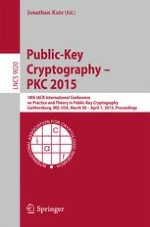This book constitutes the refereed proceedings of the 18th International Conference on Practice and Theory in Public-Key Cryptography, PKC 2015, held in Gaithersburg, MD, USA, in March/April 2015. The 36 papers presented in this volume were carefully reviewed and selected from 118 submissions. They are organized in topical sections named: public-key encryption; e-cash; cryptanalysis; digital signatures; password-based authentication; pairint-based cryptography; efficient constructions; cryptography with imperfect keys; interactive proofs; lattice-based cryptography; and identity-based, predicate, and functional encryption.
